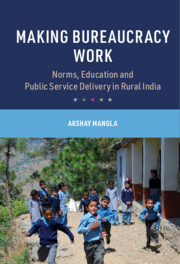Book contents
- Making Bureaucracy Work
- Cambridge Studies in the Comparative Politics of Education
- Making Bureaucracy Work
- Copyright page
- Dedication
- Contents
- Figures
- Tables
- Acknowledgments
- Abbreviations
- Part I Introduction, Puzzles and Theory
- Part II Implementing Primary Education in Northern India
- 4 How Legalistic Bureaucracy Generates Uneven Implementation
- 5 How Deliberative Bureaucracy Facilitates Adaptive Implementation
- 6 Norm Persistence
- 7 Norm Change
- Part III Comparative Extensions and Implications
- Appendix: Researching Bureaucracy and Frontline Public Services
- References
- Index
4 - How Legalistic Bureaucracy Generates Uneven Implementation
from Part II - Implementing Primary Education in Northern India
Published online by Cambridge University Press: 18 November 2022
- Making Bureaucracy Work
- Cambridge Studies in the Comparative Politics of Education
- Making Bureaucracy Work
- Copyright page
- Dedication
- Contents
- Figures
- Tables
- Acknowledgments
- Abbreviations
- Part I Introduction, Puzzles and Theory
- Part II Implementing Primary Education in Northern India
- 4 How Legalistic Bureaucracy Generates Uneven Implementation
- 5 How Deliberative Bureaucracy Facilitates Adaptive Implementation
- 6 Norm Persistence
- 7 Norm Change
- Part III Comparative Extensions and Implications
- Appendix: Researching Bureaucracy and Frontline Public Services
- References
- Index
Summary
Chapter 4 embarks on Part II of the book, the first of four empirical chapters analyzing implementation in northern India. It examines primary education in Uttar Pradesh (UP), a state that exemplifies the dynamic of legalistic bureaucracy theorized in Chapter 2. Rural UP is among the least likely setting. First, I trace the historical origins and persistence of legalistic bureaucracy in UP from the colonial era onward, but focusing on the recent period of lower caste mobilization and multiparty competition. Next, I present evidence from multilevel comparative fieldwork demonstrating how legalistic bureaucracy drives implementation over a range of administrative tasks, including school infrastructure and enrollments and provision of the Midday Meal program. I then bring the analysis down to the village-level. Taking a citizen-centric view of the state, I trace the evolution of village collective action around primary schooling over time, demonstrating how bureaucratic norms interact with citizen oversight.
Keywords
- Type
- Chapter
- Information
- Making Bureaucracy WorkNorms, Education and Public Service Delivery in Rural India, pp. 119 - 170Publisher: Cambridge University PressPrint publication year: 2022



